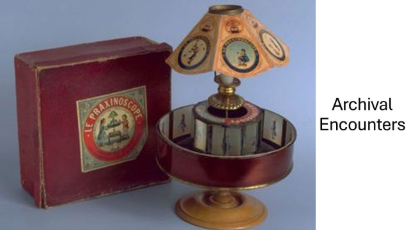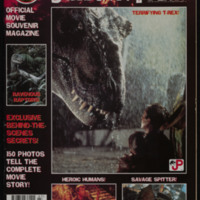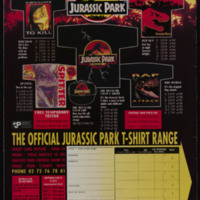Jurassic Park
Dublin Core
Title
Jurassic Park
Subject
Official Jurassic Park Movie Souvenir Magazine
Description
Jurassic Park (1993) is an official magazine about Jurassic Park (1993) movie memorabilia. The magazine includes actual stills from the movie, character introductions, and dinosaur science. It vividly describes the mystery of Jurassic Park through colorful text and pictures. The magazine provides a comprehensive account of the film, including interviews with the dinosaur experts and a behind-the-scenes look at the making of Jurassic Park. The text aims to enhance the reader's interest in the film by showcasing the art surrounding it. Whether you're a fan of the film or a dinosaur enthusiast, this magazine showcases Jurassic Park and the surrounding dinosaur expertise in multiple ways. The book is a valuable Jurassic Park collectible and advocacy book item.
The book starts with a scientific background on dinosaurs, including information on the duration of their existence and the findings of archaeological and scientific research. This is followed by an introduction to the original Jurassic Park film, which provides a brief explanation of the park and how readers can visit and explore the secrets of the dinosaurs. In this book, the author of Jurassic Park is interviewed and discusses the Dinosaur Society and the Dinosaur Books e-museum. It also begs the question of when the real Jurassic Park will open, at the beginning of the text there is a map of the real Jurassic Park, but of course we know it's only in the film. The scientific findings of the scientists and the removal of DNA from the dinosaur fossils is probably more fascinating and entertaining than the fondness for Jurassic Park (Criswell 4). This text details the process of conceptualizing the film, including the origins of the original Jurassic Park story, the challenges of adapting it for film, and how the director and screenwriter transformed Michael Crichton's novel into a film script. This information was not included in the final cut of the film. The writers of the original film also shared their thoughts and analyses of the work and the idea of building a modern Dinosaur World Park set in a dinosaur setting.
The second section partially describes the cast of actors and actresses in the Jurassic Park (1993) film, both the main and supporting roles are listed with names and backgrounds of the characters in the film, and the pictures correspond to the text, for example, actors such as Sam Neill, Laura Dern, and Jeff Goldblum have corresponding photographs and biographies. The complete story of the film is one of the things that takes up the most space in this magazine, the book presents the story from the film Jurassic Park step by step through words and pictures, presenting the plot of the film in 13 subheadings, namely Some " Thing" in The Jungle, Dig The Past, The Arrival, The Compound, Tour Begins, Dinosaur Doctors Are In, Tyrannosaurus Wrecks, Nedry Gets His, When The Bough Breaks, High-Wire Tension. Feeding Time, Nowhere To Go But Up, Rex Vs Raptors. These thirteen essays tie together the plot of the film, which is basically about billionaire Hammond's creation of a theme park called Jurassic Park. In this park, scientists have succeeded in cloning a variety of dinosaurs by copying their DNA, and plan to show them to the public as tours. To ensure the safety of the park's operations after a raptor attack, Hammond invited experts such as palaeontologist Alan Grant, palaeobotanist Ellie Sattler and mathematician Ian Malcolm to review the park. Hammond's grandson and granddaughter joined him on the tour. After the group visited the park, they were shocked and asked several questions. And that's when the park rangers switched off the park's security system in order to steal the dinosaur embryos, causing the electric fence to fail. This allowed dinosaurs, including Tyrannosaurus Rex and Velociraptor, to escape from their habitat, posing a threat to those visiting the park. They experienced a series of thrilling escapes, including an encounter with a Tyrannosaurus Rex and an escape in a Velociraptor's lair. After some thrilling escapes, Grant, Sattler, Malcolm and the children eventually make it out and are rescued by helicopter. Hammond realizes the dangers of his plan to recreate the dinosaurs and abandons the park (Spielberg 2).
This is followed by a special interview with Dr. Jack Homer, who, as a consultant on the dinosaurs in the film, is very fond of the image of the Tyrannosaurus Rex and leads to a popular science article on the dinosaurs featured in the film. These five dinosaurs are Brachiosaurus, Velociraptor, Triceratops, Tyrannosaurus rex, and Dilophosaurus. These five dinosaurs are introduced not only in the text, but also in the beautiful drawings and stills, and even in the illustration of the skeleton of the dinosaur, which allows us to understand the whole aspect of the dinosaurs. The five dinosaurs are introduced in the book with beautiful drawings and stills in addition to scientific text. Film brings science closer to the masses.
The magazine has compiled a list of other films featuring dinosaurs. One such film is The Lost World from 1925, which depicts an expedition to South America that discovers a world where dinosaurs still exist. This film was one of the first to use special effects to show dinosaurs. Another film, The Land That Time Forgot from 1975, tells the story of a shipwrecked crew that discovers an uncharted island near Antarctica inhabited by dinosaurs and other prehistoric creatures. These films are also about dinosaurs. However, the presentation of the dinosaurs is technologically rudimentary compared to the highly realistic special effects of Jurassic Park. They were all attempts to show dinosaurs using state-of-the-art technology at the time, which made an important contribution to the history of cinema and the development of special effects technology. The films were also a gift to dinosaur fans worldwide and laid a deep foundation for the later development of Jurassic Park.
The magazine concludes with a behind-the-scenes look at the making of the Dinosaur FX film. It describes the technology used to create the realistic dinosaurs, including the pioneering use of computer-generated imagery (CGI) in film production. The success of Jurassic Park demonstrated the enormous potential of CGI, despite it being in its infancy at the time. The CGI does not simply cut to the scientist's point of view. Instead, it shows long shots of the dinosaurs with the human characters in the frame. This suggests that the marvel of the moment is not just a narrative revelation of living dinosaurs, but also stunning special effects that produce realistic 3D computer-generated images of the dinosaurs (Abbott 89-108). These images blend smoothly into the live-action footage of the actors. The film also made use of dinosaur models in addition to technological techniques. The models were highly realistic, with rich detail and complex movements. The dinosaur habitat was created using real landscapes and scene arrangements, resulting in a more authentic experience.
Overall, Jurassic Park (1993) has a huge global reach because the film is epic and a whole new chapter in science fiction cinema. this magazine takes the film Jurassic Park as a starting point, combining the original Jurassic Park with an introductory analysis of the film, showing Jurassic Park in terms of plot and characters. The magazine booklet was released in conjunction with the film, but the magazine was able to teach more about the dinosaurs shown in the film. Through the film's dinosaur advisor to the dinosaurs appearing in the film to popularize the science, using a combination of pictures and text, and finally the behind-the-scenes production process of the film, leading to the positive influence of the early dinosaur films on Jurassic Park, the all-round story of the film and its behind-the-scenes cultural story, and leading the readers into the world of the dinosaurs.
Works Cited:
Criswell, Daniel. How Soon Will Jurassic Park Open?. Institute for Creation Research, 2006.
Spielberg, Steven, et al. Jurassic park. MCA Home Video Canads, 1993.
Abbott, Stacey. "Final frontiers: Computer-generated imagery and the science fiction film." Science Fiction Studies (2006): 89-108.
The book starts with a scientific background on dinosaurs, including information on the duration of their existence and the findings of archaeological and scientific research. This is followed by an introduction to the original Jurassic Park film, which provides a brief explanation of the park and how readers can visit and explore the secrets of the dinosaurs. In this book, the author of Jurassic Park is interviewed and discusses the Dinosaur Society and the Dinosaur Books e-museum. It also begs the question of when the real Jurassic Park will open, at the beginning of the text there is a map of the real Jurassic Park, but of course we know it's only in the film. The scientific findings of the scientists and the removal of DNA from the dinosaur fossils is probably more fascinating and entertaining than the fondness for Jurassic Park (Criswell 4). This text details the process of conceptualizing the film, including the origins of the original Jurassic Park story, the challenges of adapting it for film, and how the director and screenwriter transformed Michael Crichton's novel into a film script. This information was not included in the final cut of the film. The writers of the original film also shared their thoughts and analyses of the work and the idea of building a modern Dinosaur World Park set in a dinosaur setting.
The second section partially describes the cast of actors and actresses in the Jurassic Park (1993) film, both the main and supporting roles are listed with names and backgrounds of the characters in the film, and the pictures correspond to the text, for example, actors such as Sam Neill, Laura Dern, and Jeff Goldblum have corresponding photographs and biographies. The complete story of the film is one of the things that takes up the most space in this magazine, the book presents the story from the film Jurassic Park step by step through words and pictures, presenting the plot of the film in 13 subheadings, namely Some " Thing" in The Jungle, Dig The Past, The Arrival, The Compound, Tour Begins, Dinosaur Doctors Are In, Tyrannosaurus Wrecks, Nedry Gets His, When The Bough Breaks, High-Wire Tension. Feeding Time, Nowhere To Go But Up, Rex Vs Raptors. These thirteen essays tie together the plot of the film, which is basically about billionaire Hammond's creation of a theme park called Jurassic Park. In this park, scientists have succeeded in cloning a variety of dinosaurs by copying their DNA, and plan to show them to the public as tours. To ensure the safety of the park's operations after a raptor attack, Hammond invited experts such as palaeontologist Alan Grant, palaeobotanist Ellie Sattler and mathematician Ian Malcolm to review the park. Hammond's grandson and granddaughter joined him on the tour. After the group visited the park, they were shocked and asked several questions. And that's when the park rangers switched off the park's security system in order to steal the dinosaur embryos, causing the electric fence to fail. This allowed dinosaurs, including Tyrannosaurus Rex and Velociraptor, to escape from their habitat, posing a threat to those visiting the park. They experienced a series of thrilling escapes, including an encounter with a Tyrannosaurus Rex and an escape in a Velociraptor's lair. After some thrilling escapes, Grant, Sattler, Malcolm and the children eventually make it out and are rescued by helicopter. Hammond realizes the dangers of his plan to recreate the dinosaurs and abandons the park (Spielberg 2).
This is followed by a special interview with Dr. Jack Homer, who, as a consultant on the dinosaurs in the film, is very fond of the image of the Tyrannosaurus Rex and leads to a popular science article on the dinosaurs featured in the film. These five dinosaurs are Brachiosaurus, Velociraptor, Triceratops, Tyrannosaurus rex, and Dilophosaurus. These five dinosaurs are introduced not only in the text, but also in the beautiful drawings and stills, and even in the illustration of the skeleton of the dinosaur, which allows us to understand the whole aspect of the dinosaurs. The five dinosaurs are introduced in the book with beautiful drawings and stills in addition to scientific text. Film brings science closer to the masses.
The magazine has compiled a list of other films featuring dinosaurs. One such film is The Lost World from 1925, which depicts an expedition to South America that discovers a world where dinosaurs still exist. This film was one of the first to use special effects to show dinosaurs. Another film, The Land That Time Forgot from 1975, tells the story of a shipwrecked crew that discovers an uncharted island near Antarctica inhabited by dinosaurs and other prehistoric creatures. These films are also about dinosaurs. However, the presentation of the dinosaurs is technologically rudimentary compared to the highly realistic special effects of Jurassic Park. They were all attempts to show dinosaurs using state-of-the-art technology at the time, which made an important contribution to the history of cinema and the development of special effects technology. The films were also a gift to dinosaur fans worldwide and laid a deep foundation for the later development of Jurassic Park.
The magazine concludes with a behind-the-scenes look at the making of the Dinosaur FX film. It describes the technology used to create the realistic dinosaurs, including the pioneering use of computer-generated imagery (CGI) in film production. The success of Jurassic Park demonstrated the enormous potential of CGI, despite it being in its infancy at the time. The CGI does not simply cut to the scientist's point of view. Instead, it shows long shots of the dinosaurs with the human characters in the frame. This suggests that the marvel of the moment is not just a narrative revelation of living dinosaurs, but also stunning special effects that produce realistic 3D computer-generated images of the dinosaurs (Abbott 89-108). These images blend smoothly into the live-action footage of the actors. The film also made use of dinosaur models in addition to technological techniques. The models were highly realistic, with rich detail and complex movements. The dinosaur habitat was created using real landscapes and scene arrangements, resulting in a more authentic experience.
Overall, Jurassic Park (1993) has a huge global reach because the film is epic and a whole new chapter in science fiction cinema. this magazine takes the film Jurassic Park as a starting point, combining the original Jurassic Park with an introductory analysis of the film, showing Jurassic Park in terms of plot and characters. The magazine booklet was released in conjunction with the film, but the magazine was able to teach more about the dinosaurs shown in the film. Through the film's dinosaur advisor to the dinosaurs appearing in the film to popularize the science, using a combination of pictures and text, and finally the behind-the-scenes production process of the film, leading to the positive influence of the early dinosaur films on Jurassic Park, the all-round story of the film and its behind-the-scenes cultural story, and leading the readers into the world of the dinosaurs.
Works Cited:
Criswell, Daniel. How Soon Will Jurassic Park Open?. Institute for Creation Research, 2006.
Spielberg, Steven, et al. Jurassic park. MCA Home Video Canads, 1993.
Abbott, Stacey. "Final frontiers: Computer-generated imagery and the science fiction film." Science Fiction Studies (2006): 89-108.
Creator
Publisher: Nick Landau
Executive Manager- Magazines: Leigh Baulch
Managing Editor- Books: Katy Wild
Production Controller: Bob Kelly
Painting : Brian Franczak
Cover Designer: Chris Teather
Additional Typesetting: Darren Clark
Executive Manager- Magazines: Leigh Baulch
Managing Editor- Books: Katy Wild
Production Controller: Bob Kelly
Painting : Brian Franczak
Cover Designer: Chris Teather
Additional Typesetting: Darren Clark
Source
Magazine illustration source: Jurassic Park film stills
Anatomical drawing : Gregory S. Paul
Anatomical drawing : Gregory S. Paul
Publisher
Titan Books Limited
Date
1992 Universal City Studios, Inc. & Amblin Entertainment, Inc.
Contributor
Xusikun Xin
Rights
Copyright:Universal City Studios, Inc. & Amblin Entertainment, Inc.
Originally published by the Topps Company, Inc.
Originally published by the Topps Company, Inc.
Format
Book: length 275mm; breadth 200mm; height 4mm
Language
English
Type
An official film magazine
Identifier
ISSN 1350-0368
Text Item Type Metadata
Text
64 pages
Original Format
Paper, Photo
Collection
Citation
Publisher: Nick Landau
Executive Manager- Magazines: Leigh Baulch
Managing Editor- Books: Katy Wild
Production Controller: Bob Kelly
Painting : Brian Franczak
Cover Designer: Chris Teather
Additional Typesetting: Darren Clark
, “Jurassic Park,” Archival Encounters: Digital Exhibitions form the Bill Douglas Cinema Museum, accessed July 16, 2025, https://humanities-research.exeter.ac.uk/archivalencounters/items/show/15.


